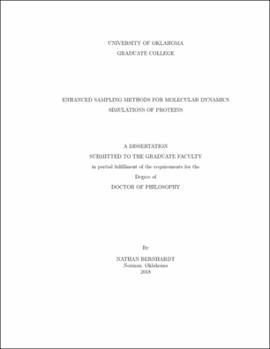| dc.contributor.advisor | Hansmann, Ulrich | |
| dc.contributor.author | Bernhardt, Nathan | |
| dc.date.accessioned | 2018-09-24T16:47:34Z | |
| dc.date.available | 2018-09-24T16:47:34Z | |
| dc.date.issued | 2018-12 | |
| dc.identifier.uri | https://hdl.handle.net/11244/301810 | |
| dc.description.abstract | Due to the many folds existing in nature, proteins are able to perform a multitude of functions within cells. This relationship between structure and function is one of great importance and has added to the understanding of human disease. With the development of the energy landscape theory, a theoretical description of protein folding has emerged and it is now understood that proteins exhibit a funnel-shaped energy landscape. This model has been widely used for interpreting experimental data but is not able to explain folding for all proteins. For example, there now exists evidence in support of a multi-funnel theory such as that from studies of the proteins GA98, GB98 and RfaH. Probing these landscapes is challenging and many details of their topology, such as transition and intermediate states, remain unknown. Aiding in this task have been computer simulations and special algorithms designed to enhance exploration of protein landscapes like replica exchange molecular dynamics (REMD). While REMD enables calculation of thermodynamic quantities, the method is restricted to rather small protein systems. For this reason, the replica-exchange-with-tunneling (RET) method is introduced in this text and enables fast and efficient exploration of protein landscapes for protein systems of increased size. Using RET and a variant of the multiscale essential sampling (MSES) method combined with a Go-model, simulations of the fold switching proteins GA98, GB98 and RfaH-CTD are performed thus revealing the biophysical interactions driving their behavior. This method is then modified to include the use of a coarse-grained model thereby extending the use of RET to a broader class of protein. Continuing in this direction, a single step resolution exchange method, referred to as resolution-exchange-with-tunneling (ResET), is introduced and makes possible the highly efficient exploration of any protein landscape. | en_US |
| dc.language | en_US | en_US |
| dc.subject | replica exchange | en_US |
| dc.subject | markov chain Monte Carlo | en_US |
| dc.subject | resolution exchange with tunneling | en_US |
| dc.subject | enhanced sampling | en_US |
| dc.title | Enhanced Sampling Methods for Molecular Dynamics Simulations of Proteins | en_US |
| dc.contributor.committeeMember | Rice, Charles | |
| dc.contributor.committeeMember | Sharma, Indrajeet | |
| dc.contributor.committeeMember | Rajan, Rakhi | |
| dc.contributor.committeeMember | Huang, Liangliang | |
| dc.date.manuscript | 2018-09-21 | |
| dc.thesis.degree | Ph.D. | en_US |
| ou.group | College of Arts and Sciences::Department of Chemistry and Biochemistry | en_US |
| shareok.orcid | https://orcid.org/0000-0003-4309-4644 | en_US |
| shareok.nativefileaccess | restricted | en_US |
